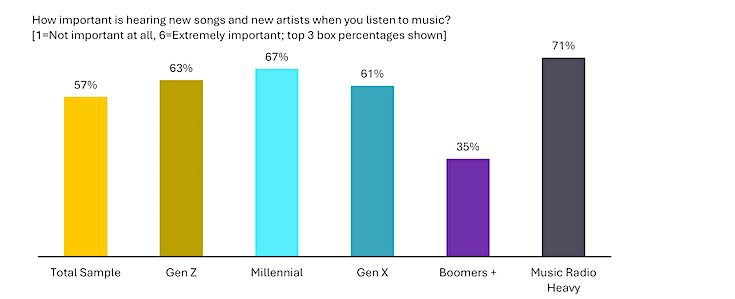Moneyball: Radio’s Role for Music Discovery
• With the deep history between radio and music, many of us recall a time when radio was the top of the heap when for music discovery. To understand where things stand today, we first need to determine who’s interested in new music. Across a sample of over 2,900 people nationwide, 57% give a very high rating to the importance of “hearing new songs and new artists” when they listen to music. As shown in the chart below, it’s not surprising that new music is important to more younger people than it is among people over 60.


Keep in mind, this is a wide sample — starting at age 14 and with no top end. We have the entire Baby Boom and as much of the Silent Generation as we can get in a study conducted online, but three quarters of the sample is comprised of members of generations younger than Baby Boomers (including almost all of Generation Z, the so-called “Zoomers”).


There’s not a strong variance among the three younger generations in the sample. Millennials (ages 29-44) are the highest number at 67%, while the youngest, Gen Z (ages 14-28) are only a couple of points higher than Gen X (ages 45-60). It’s among Boomers and beyond (ages 61+) where new music sags, remaining highly important to just over a third.


When we ask the 57% of the sample who tell us that new songs and new artists are very important to them which sources regularly help them “discover new artists or songs,” Radio lands several points ahead of streaming music apps, labeled “Spotify, etc.” in the table below. The generations tell a more nuanced story, with Radio far ahead of “Spotify, etc.” among Boomers and even Gen X. “Spotify, etc.” pulls ahead of Radio among Millennials and Gen Z. But the headline about new music discovery is social media, which has the lead among Gen Z, Millennials, and Gen X.


Perhaps especially among those who listen to music radio at least two hours a day, social media has the lead — cited by nearly half of the Music Radio Heavies, several points ahead of radio itself, though groups of a third or more are influenced by other sources, including streaming music services, TV, movies, and video games.
If you’re in charge of determining the new songs that get on the air at a radio station where new music is important, the number of places where listeners MIGHT be exposed to a new song they love is dizzying. Yet the advent of personal media means that many of your listeners might be loving new songs on TikTok, but those listeners may well be loving different songs. In fact, each listener might be reveling in an entirely different song.
Music radio is about consensus — keeping many listeners satisfied with one music schedule. While you need to monitor social media and other channels to stay abreast of new songs that are gaining attention with people in your station’s demographic, you also need to balance that against which new songs are familiar to a wide enough portion of your audience to deserve exposure on your station.
It can be tempting to conclude that big streaming stats or massive numbers in Social media indicate that most of a station’s audience is teed up for a new track, but those metrics (national streaming and Socials) can be misleading. Where possible, local music research can accurately show the existing awareness and passion for new titles and inform about fatigue on older songs.
We’d love to help your stations stay ahead of the competition with our effectively priced offerings for both marketing and research. An email to tellmemore@nuvoodoo.com will get you quick attention from the right member of our team. — Leigh Jacobs



